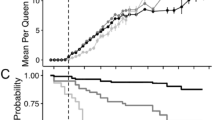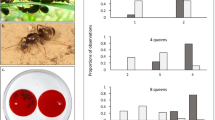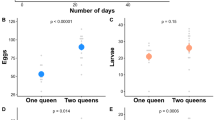Abstract
SOCIAL insect colonies are in many ways analogous to organisms1, because kin-selected workers act selflessly and cohesively to promote the fitness of a few reproductive members2,3. But workers can evolve selfish strategies which create reproductive conflict, reducing the functional integrity of colonies. For example, they can lay unfertilized (male) eggs3–6, compete directly with the queen to lay fertilized (female) eggs7, suppress the reproduction of other workers8,9, choose among several queens10 and generally favour closer over more distant kin11. Conflicts over the sex ratio may be especially pervasive, even in highly eusocial insects. The unusually high relatedness (r = 3/4) of female hymenopteran workers to their full sisters means that workers should prefer more female-biased sex ratios than do queens4. The worker preference for females should be exerted most strongly on colonies where they are most likely to be full sisters, leaving male production to colonies where this advantage least applies4,12–14; this prediction is supported by studies in ants and bees12,15–17. Here we show that when colonies havezmultiple queens born in the same nest, the selfish worker sex-ratio strategy has a paradoxical side-effect which strongly promotes social cohesion. This strategy accounts for the peculiar colony cycle of epiponine wasps, and may be responsible for the maintenance of eusociality in this group.
This is a preview of subscription content, access via your institution
Access options
Subscribe to this journal
Receive 51 print issues and online access
$199.00 per year
only $3.90 per issue
Buy this article
- Purchase on Springer Link
- Instant access to full article PDF
Prices may be subject to local taxes which are calculated during checkout
Similar content being viewed by others
References
Wheeler, W. M. J. Morph. 22, 307–325 (1911).
Hamilton, W. D. J. theor. Biol. 7, 1–16, 17–52 (1964).
Hamilton, W. D. A. Rev. ecol. Syst. 3, 193–232 (1972).
Trivers, R. L. & Hare, H. Science 191, 249–263 (1976).
Bourke, A. F. G. Q. Rev. Biol. 63, 291–311 (1988).
Choe, J. C. in Advances in Myrmecology (ed. Trager, J. C.) 163–187 (Brill, Leiden, 1988).
Sommer, K. & Hölldobler, B. Naturwissenschaften 79, 470–472 (1992).
Starr, C. K. in Sperm Competition and the Evolution of Animal Mating Systems (ed. Smith, R. L.) 427–464 (Academic, Orlando, 1984).
Ratnieks, F. L. W. & Visscher, P. K. Nature 342, 796–797 (1989).
Forsyth, A. Am. Nat. 116, 895–898 (1980).
Getz, W. in Kin Recognition (ed. Hepper, P.) 358–412 (Cambridge Univ. Press, UK, 1991).
Boomsma, J. J. & Grafen, A. Evolution 44, 1026–1034 (1990).
Boomsma, J. J. & Grafen, A. J. evol. Biol. 3, 383–407 (1991).
Pamilo, P. Am. Nat. 137, 83–107 (1991).
Ward, P. S. Behav. Ecol. Sociobiol. 12, 301–307 (1983).
Boomsma, J. J. Trends ecol. Evol. 6, 92–95 (1991).
Mueller, U. G. Science 254, 442–444 (1991).
Queller, D. C., Strassmann, J. E. & Hughes, C. R. Science 242, 1155–1157 (1988).
Wade, M. J. J. theor. Biol. 112, 109–121 (1985).
Carpenter, J. in Biological Relationships Between Africa and South America (ed. Goldblatt, P.) (Yale Univ. Press, New Haven, in the press).
Richards, O. W. The Social Wasps of the Americas Excluding the Vespinae (British Museum (Natural History), London, 1978).
Jeanne, R. L. A. Rev. Ent. 25, 371–396 (1980).
Jeanne, R. L. in The Social Biology of Wasps (eds Ross, K. & Matthews, R.) 191–231 (Cornell Univ. Press, Ithaca, New York, 1991).
West-Eberhard, M. J. in Social Insects in the Environment Proc. 11th int. Congr. IUSSI (eds Veeresh, G. K., Mallik, B. & Viraktamath, C. A.) 254–255 (Oxford and IBH, New Delhi, 1990).
Strassmann, J. E. et al. Anim. Behav. 42, 461–470 (1991).
Queller, D. C. et al. Behavl Ecol. 4, 7–13 (1993).
Gastreich, K. R., Strassmann, J. E. & Queller, D. C. Ecol. Ethol. Evol. (in the press).
West-Eberhard, M. J. in Proc. 7th int. Congr. IUSSI 396–403 (1973).
West-Eberhard, M. J. Science 200, 441–443 (1978).
West-Eberhard, M. J. in Natural Selection and Social Behaviour (eds Alexander, R. D. & Tinkle, D. W.) 3–17 (Chiron, New York, 1981).
Forsyth, A. B. thesis, Harvard Univ. (1978).
Queller, D. C. & Goodnight, K. F. Evolution 43, 258–275 (1989).
Author information
Authors and Affiliations
Rights and permissions
About this article
Cite this article
Queller, D., Strassmann, J., Solís, C. et al. A selfish strategy of social insect workers that promotes social cohesion. Nature 365, 639–641 (1993). https://doi.org/10.1038/365639a0
Received:
Accepted:
Published:
Issue Date:
DOI: https://doi.org/10.1038/365639a0
This article is cited by
-
Nesting biology and social organisation of the allodapine bee Exoneura angophorae (Hymenoptera: Apidae): montane environmental constraints yield biased sex allocation yet phenology is unhindered
Insectes Sociaux (2021)
-
Genetic relatedness does not predict the queen’s successors in the primitively eusocial wasp, Ropalidia marginata
Journal of Genetics (2018)
-
The origin of a primordial genome through spontaneous symmetry breaking
Nature Communications (2017)
-
Pushing Wasps to Work: Decentralized Aggression Induces Increased Activity in the Paper Wasp Polistes versicolor
Journal of Insect Behavior (2017)
-
Mutually beneficial host exploitation and ultra-biased sex ratios in quasisocial parasitoids
Nature Communications (2014)
Comments
By submitting a comment you agree to abide by our Terms and Community Guidelines. If you find something abusive or that does not comply with our terms or guidelines please flag it as inappropriate.



